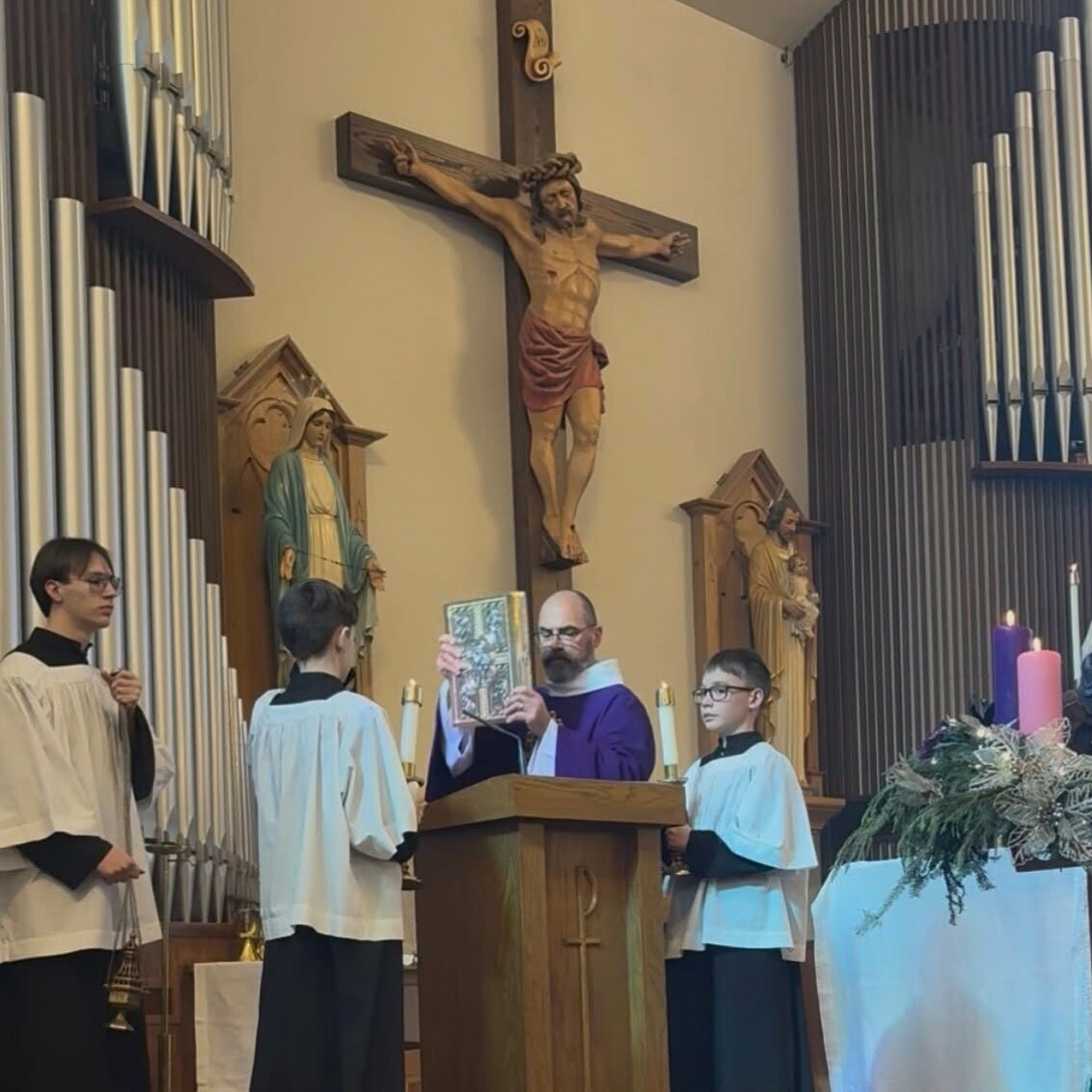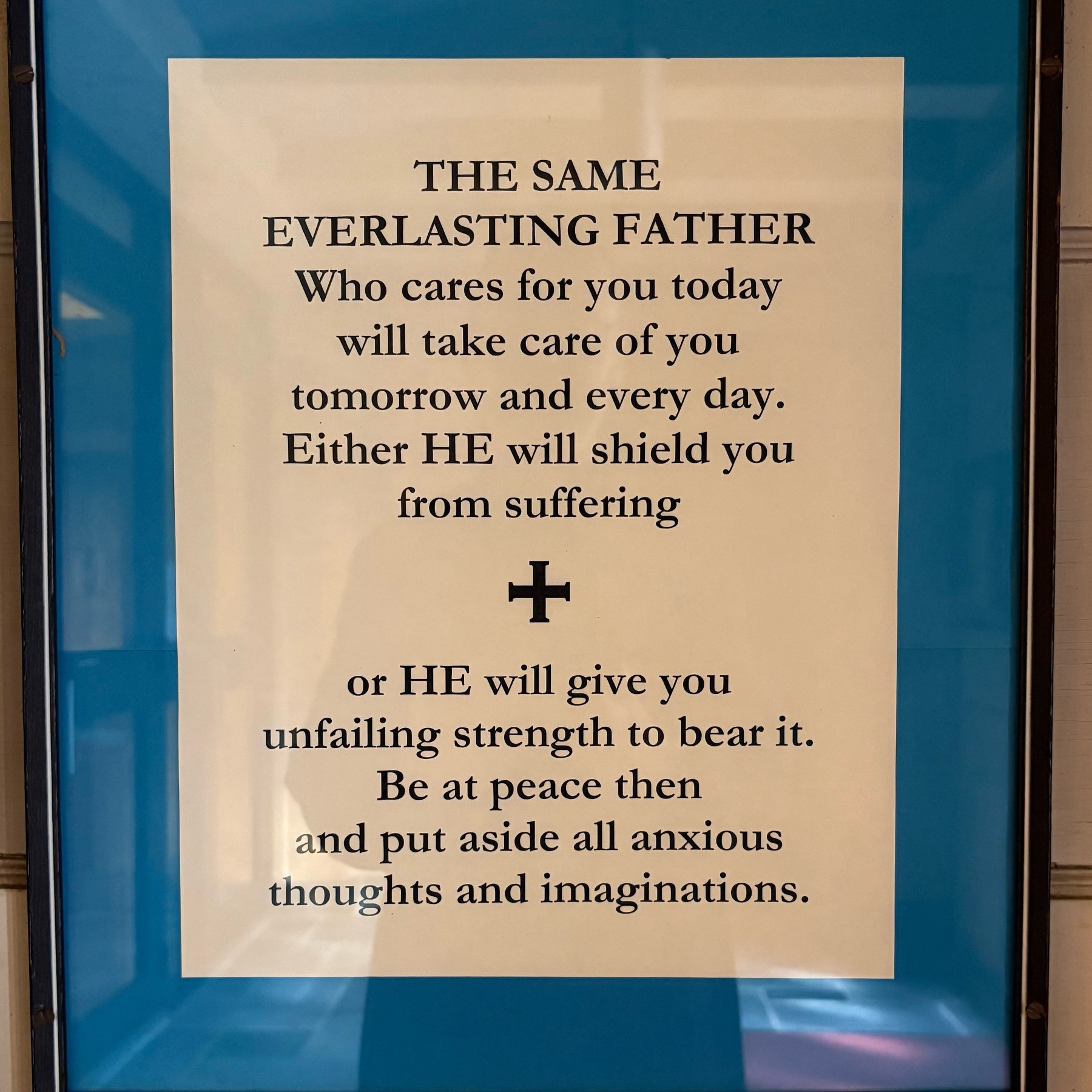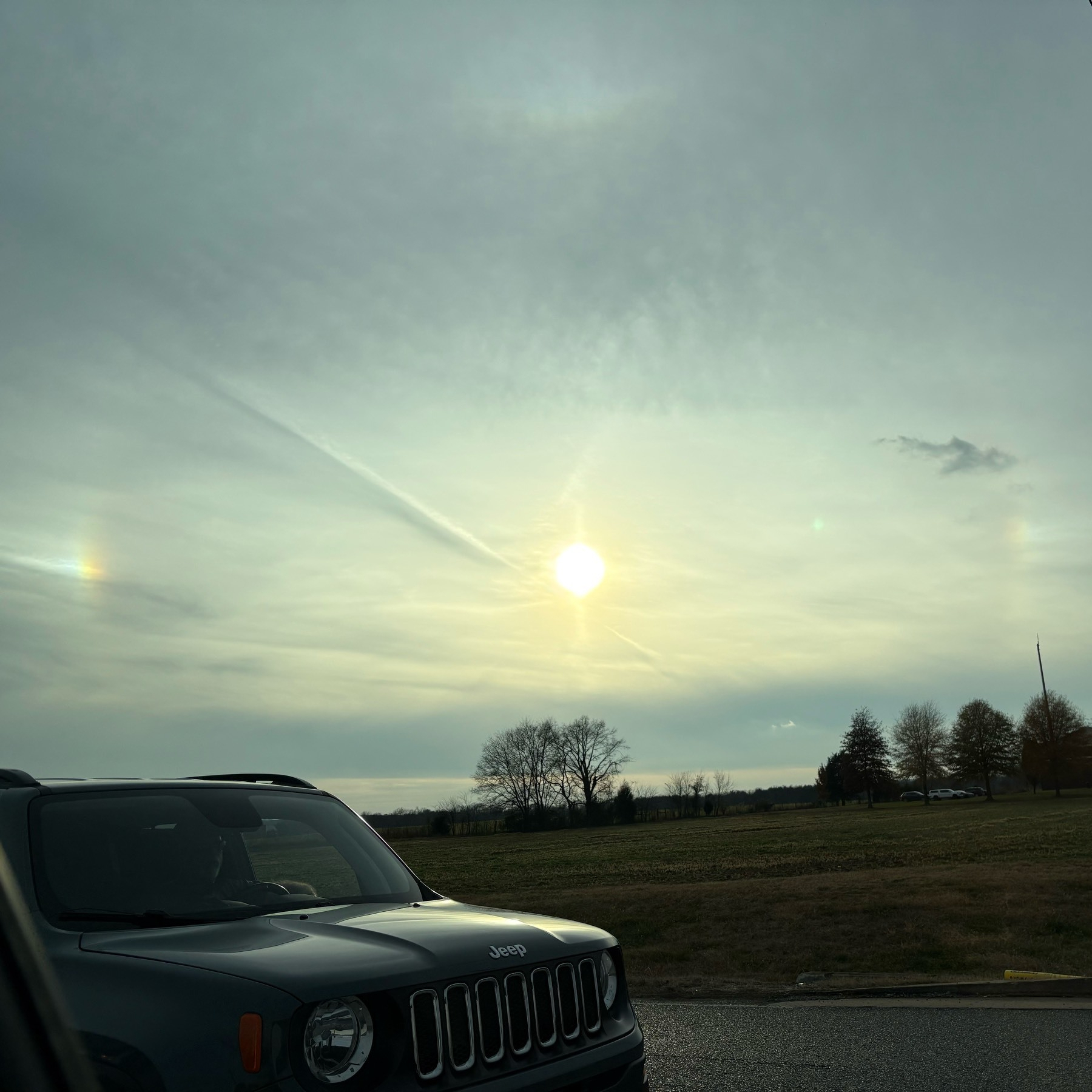Back at it
Not so bleak indeed. The highs may reach 70 here by the weekend. I can’t say that I hate it, but am also sort of bracing for the inevitable cold spells to come. Feels like we’ll need to pay for this mildness at some point. Or maybe not. We’ll see.
We finished up Stranger Things. Sure there were plot holes, but whatever. A decent enough homage to 80’s era pulp sci-fi/fantasy, though they went a little lighter on the nostalgia that was more evident in the first couple of seasons. We also finished up Down Cemetery Road which we also liked. Not surprising, we very much like Slow Horses too. Enjoying Elric and Slay the Spire. I was delighted to see that it’s available as a standalone iPad game, but have opted (for now) to keep it restricted to my workstation. I like it too much right now to grant myself even easier access to it.
So everyone’s back to work and school today and trying to get back into the normal routine. I have homilies to prepare for this weekend and some business travel set for the week after. Then it will be cold again, but we’ll be a couple of weeks closer to spring.
Oramos también por nuestras hermanos y hermans Venezolanos, que la verdadera paz de Cristo esté con ellos, dondequeria que estén.

Currently reading: Elric of Melniboné by Michael Moorcock 📚

Currently reading: The Diary of a Country Priest by Georges Bernanos 📚
The not-so-bleak midwinter
Only 3 more masses at my home parish: 7PM on the Solemnity, and two Vigils (English and Spanish) of this upcoming Sunday. After that it’s full-tilt at St. William; the pastor and I have already been hammering out the next month or two, which will include covering for him while he’s out of the country for a couple of weeks. Practically speaking, this means communion services - Word and Eucharist, but the Eucharist will be distributed from what’s reserved in the tabernacle. A priest will be in for the Sunday masses, so we should be in good shape to keep things going. I’ll do at least one Exposition/Benediction while he’s out and…I guess be on-hand as much as my job allows.
Fortunately for me I’ll have a couple of weeks to settle in there before flying solo. I’ll need them to get a sense of How Things Are Done, which is to say What The People Expect. Fun stuff. I’m excited and (of course) a little nervous. God will supply what I am certainly lacking.
Absolutely unrelated: I’ve put Factorio aside for now. The truth is that I haven’t played since about this time last year, so first I needed to apply a year’s worth of updates. Then I opened my last save and stared at it, trying to remember the keyboard mappings, the new things added by the Space Age expansion, and my general state of mind as regards belts and defenses. Then I gauged how much I’d have to grind to launch the rocket and actually see the new Space Age stuff, and I compared that to the amount of time I actually have and, Reader, the news was not good.
So: off to peruse Steam’s winter sale, and I came away with Megabonk, which is very similar to Vampire Survivors in game-play. I also grabbed Slay the Spire, another rogue-like with deck-building which seemed crazy popular a little while back. Both of these look to fit the bill perfectly. And for, what, a combined total of $11? That’s crazy cheap, even for me.
I’m going to hang up The Book of Disquiet. I’m nearly at the end. The little texts are beautifully written, but the speaker is something of a nudge, and it’s getting a little old. I’ve got other things in the stack to get through and have been eyeballing a revisit to Michael Moorcock, who I haven’t read since…gosh, high school, probably. I don’t know if I ever actually finished the Elric books, but all of them are available in a three-volume set, so really, what’s my excuse?
Homily for the Solemnity of the Holy Family
It is something of a cliche to talk about Man’s search for God. We are constantly seeking for Him everywhere. We look for truth in science, we look for new frontiers, new freedoms, and new ways of understanding the world.
The Incarnation of Christ shows us, however, that the truth is completely inverted, and has always been about God’s search for us. This search began in a garden and can be seen throughout the entirety of the scriptures. God has been seeking his people, testing them, refining them, and preparing them for the most improbable thing ever. He would cross the infinite space between Him and His creation, entering into the world in a way we could know Him and this most extraordinary thing would happen in the most ordinary place: in a family.
We’ve read the genealogy of Jesus several times in the past week - once at the vigil, and beforehand during daily Mass. Our Lord’s family tree is no boastful list of kings and might heroes, though there are a few of those in there. Most of the names in there are pretty ordinary, relatively speaking. And as anyone who’s worked on their family tree knows, there are a couple of questionable names in there too. If you’ve worked on your own tree and haven’t found the colorful or questionable names yet, I have some bad news for you, because it just might be you.
But names and lines and boxes on a family tree hardly do justice to the enormity of what we see: entire lives, lived in ordinary times, suffering and celebrating the same way we do.
Families are a central part of God’s plan, and reflect the way he wants us to know Him, for this is how He came to us. Families are the places that we learn to love, to pray, and to serve. They are perfect little communities and the basic cell of any human society.
Families begin in faith, starting with the promises and consent of marriage, each person trusting in God to deliver on the promises of grace to live out the vocation of Marriage.
Families grow in hope! Hope by its very nature is oriented to the future, to what’s ahead, not what’s past. And just as we are here because of the hopes of those who’ve come before us, so we pay it forward, and pass it to those who will come after us.
Families abide in love, in the relations between their members. Families are the first places we learn who we are as we learn about others. Babies only know three people in the world: themselves, Mom, and Not-Mom. As we mature, though, we come to a greater understanding of our selves. Once we know our self, we can learn what it is to love selflessly, in agape.
Now I say all that to say this: families can also screw things up pretty badly. This crucible that forms us can also be a place of pain, of hurt. He knows about this too. But little by little, we can - with His grace - begin to inch things back into their proper place. It may take years; we might not ever finish. This is fine. We might think about forgiving a hurt or a sleight. If not for the other person, than as a gift we can dare to give to ourselves, letting go of a weight we no longer need to carry.
So let’s take a look at the Holy Family as a model and guide, and I realize that sounds like something of a tall order. After all, we have the Son of God, the Immaculate Conception, and saintly Joseph. That’s a pretty tough act to follow. A closer look at the Holy Family reveals some beautiful catechesis:
They are obedient to God’s will. Joseph got up in the middle of night to move his family to safety. Any of us would do the same of course. But what about in the many small things of life? Are we as ready to obey God in small moments as well?
They are attentive to God in prayer. The most remarkable thing about the infancy narratives - the stories of our Lord’s childhood - is their silence. We don’t hear much from them at all. This silence invites us to create spaces of silence in our own lives, a place to share in the silence of Bethlehem and Nazareth. Silence is necessary for prayer and prayer is a non-negotiable part of our interior lives. Let’s look for some of their silence and sit in it for awhile this season.
Finally, the Holy Family moved quickly and decisively. If you’ve been discerning God’s call to your something, whatever it is, it may be time to step off the boat and trust in Him for the next steps. In formation, they called this ‘setting your hand to the plow’ and moving ahead. Let us all pray for the grace to act.
G.K. Chesterton wrote:
When we step into the family, by the act of being born, we do step into a world which is incalculable, into a world which has its own strange laws, into a world which could do without us, into a world we have not made. In other words, when we step into a family, we step into a fairy-tale.
Our Lord stepped into a fairy-tale by entering into a family, only He was the author and he came to show us how the story will end.
All of our greatest stories begin in families and find their frameworks, their contexts, in families. The story of our redemption is no different. Neither is yours or mine.
Let us then follow the Holy Family, learning from them the silence of prayer, obedience to God’s will, and willingness to follow wherever it leads. Let us follow them from Bethlehem to Egypt, and from Egypt to Nazareth, and from Nazareth to Jerusalem.
Amen.
Feast of St. Stephen the Protomartyr (and deacon)
Merry Christmas! I trust that everyone is having a good one. Several more days to go until we’ve run through all twelve, so probably wise to pace yourself. For example, I don’t usually open the monastery fruitcake until a few days after the 25th. True, this is because the house is still stacked with other desserts; I don’t want the fruitcake to get lost in the shuffle.
Christmas Mass was lovely and the first Spanish liturgy at which I’ve assisted. I’ll get plenty more opportunities to assist (and preach) in Spanish soon enough. As it is, I’m preaching on Sunday for the Solemnity of the Holy Family. Will be working on that a bit later. Today was mostly about cleanup, a few errands out and about, and the construction of another terrarium. I made one last year and it’s survived pretty well since then, so when we were about to throw out a large glass drink dispenser earlier this summer, I set it aside for just this purpose. Now it hosts a small fern, false aralia, and a bit of pixie ivy. Now when the dreariness of JanuFeb hits with its full force, I can look over at my tiny bit of rain forest and daydream until spring. In the meanwhile, we’ve come to really savor the latter days of the Octave. Most of us are still on vacation and things are quiet. Right about the time the walls start moving inward, it will be time to get back to work and it might even feel like a bit of relief. Or at least for a few days anyway.
The Liturgy of the Hours was a sobering change-up in the midst of all the Christmas rejoicing. One moment you’re tooling along with “Rejoice! Rejoice!” and then you’re reading the martyrdom of Stephen, one of the first deacons and the first to die for Christ. Our own turns will come, probably in thousands of small ways rather than one big one. Tomorrow, which is also my birthday, the Church celebrates the Feast of St. John the Evangelist. I get to do my first home blessing, too. Solidly festive, if you ask me.
Peace and God Bless.
More pictures from Saturday, courtesy of my oldest daughter’s excellent eye, which can make even me look pretty good.
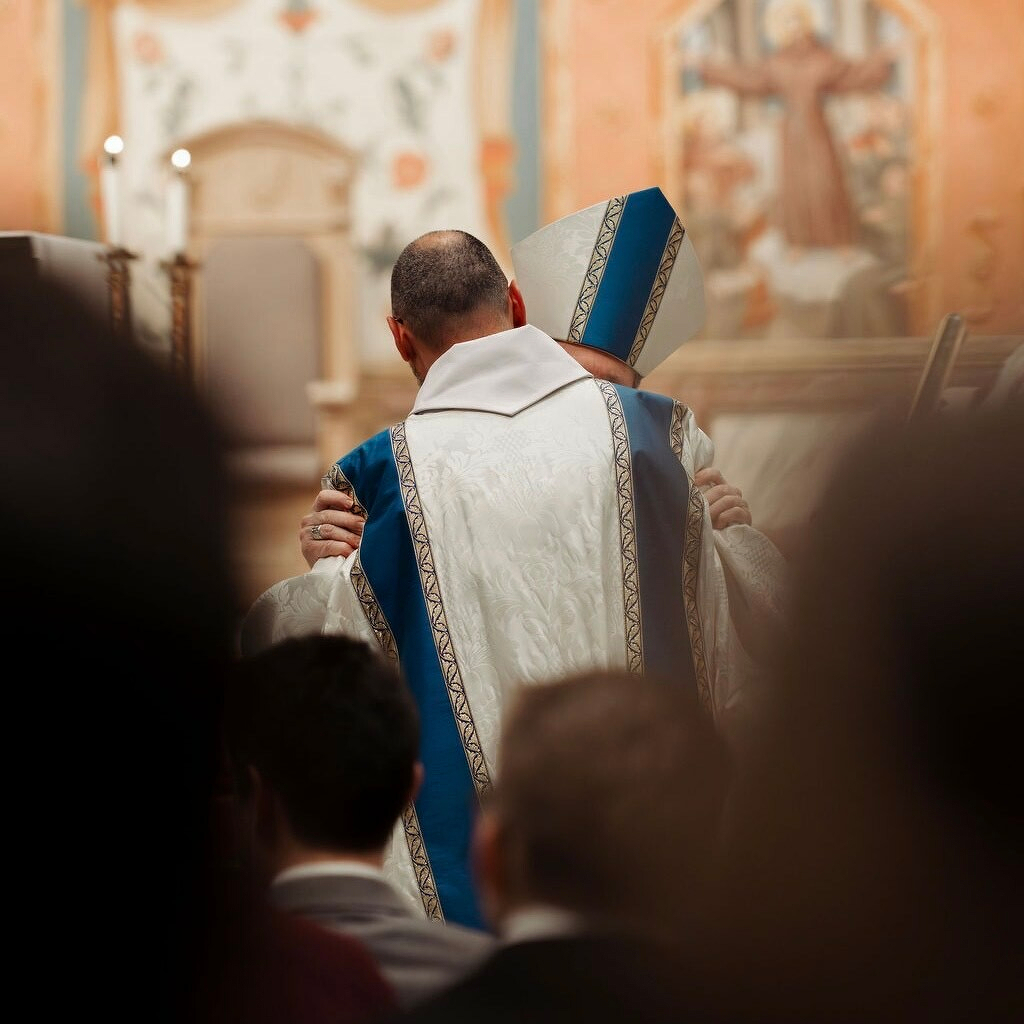
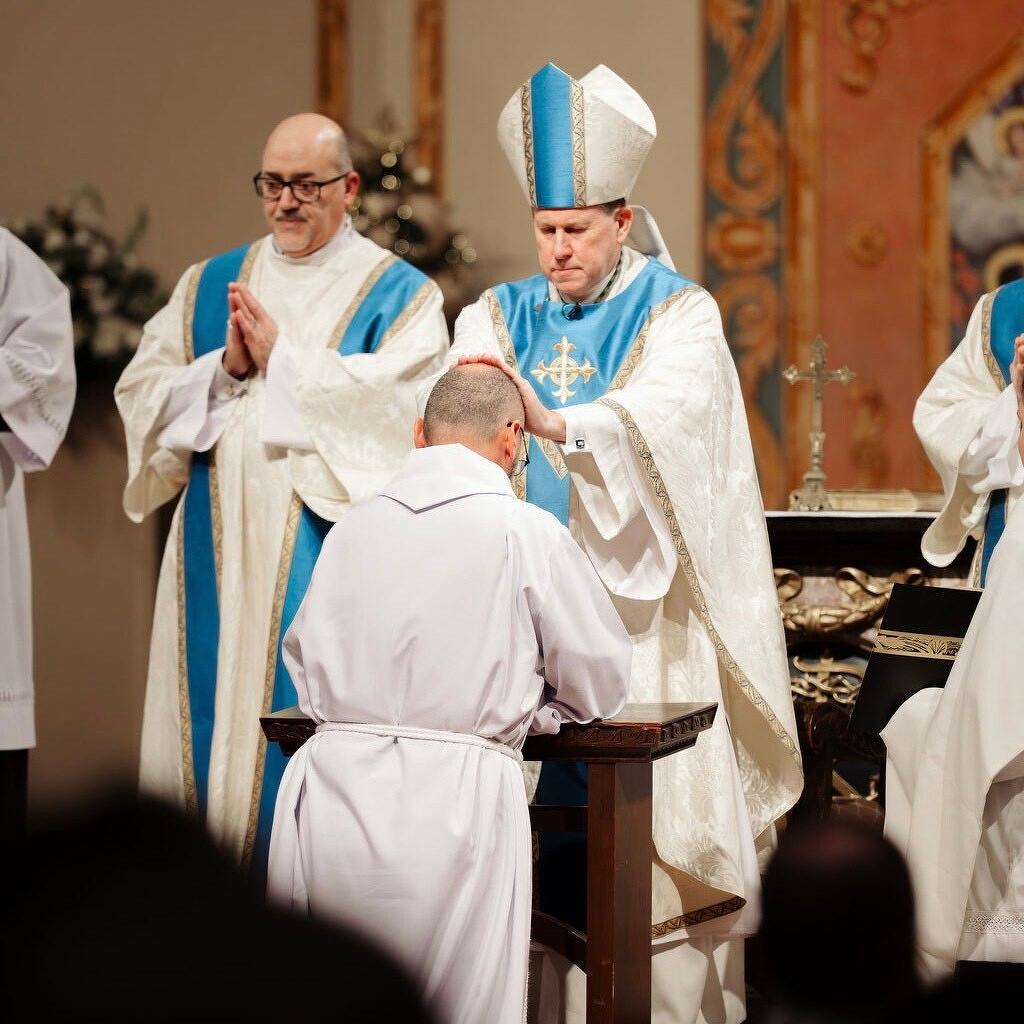
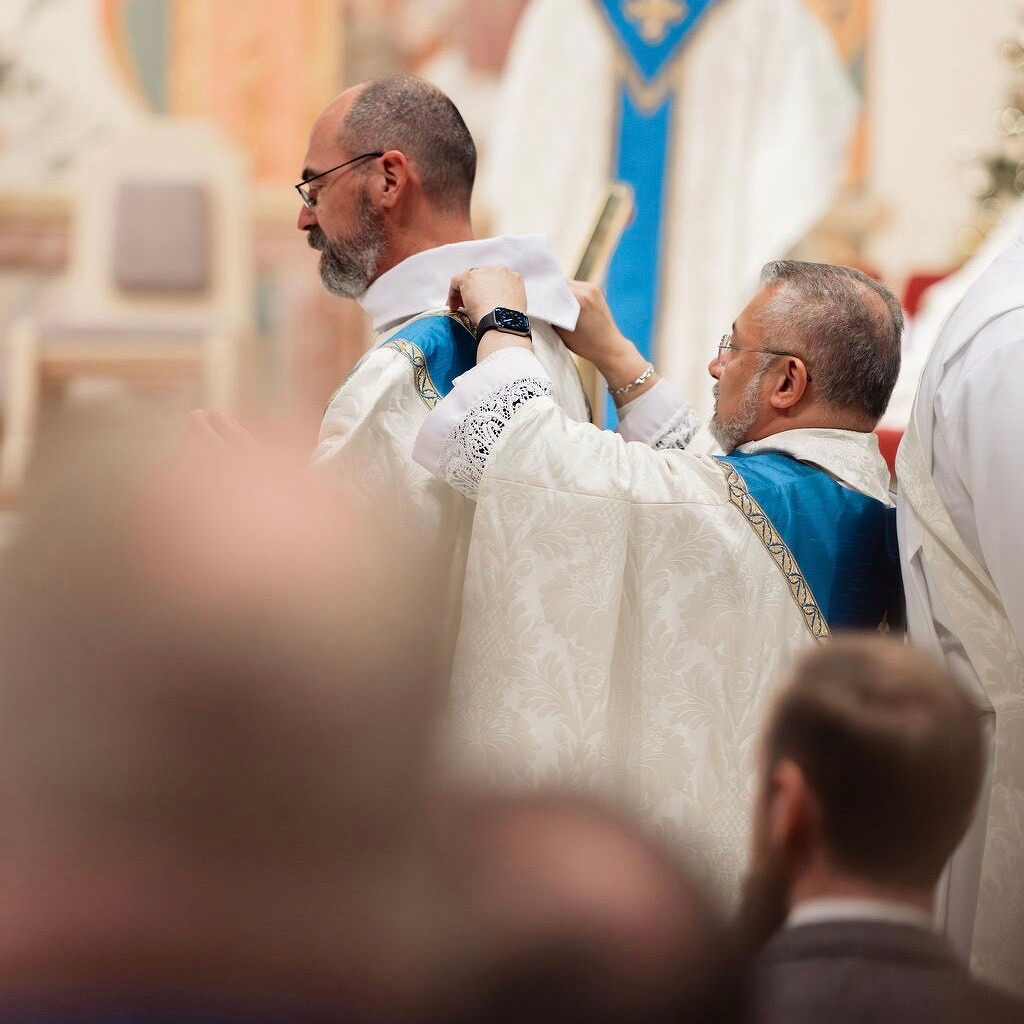
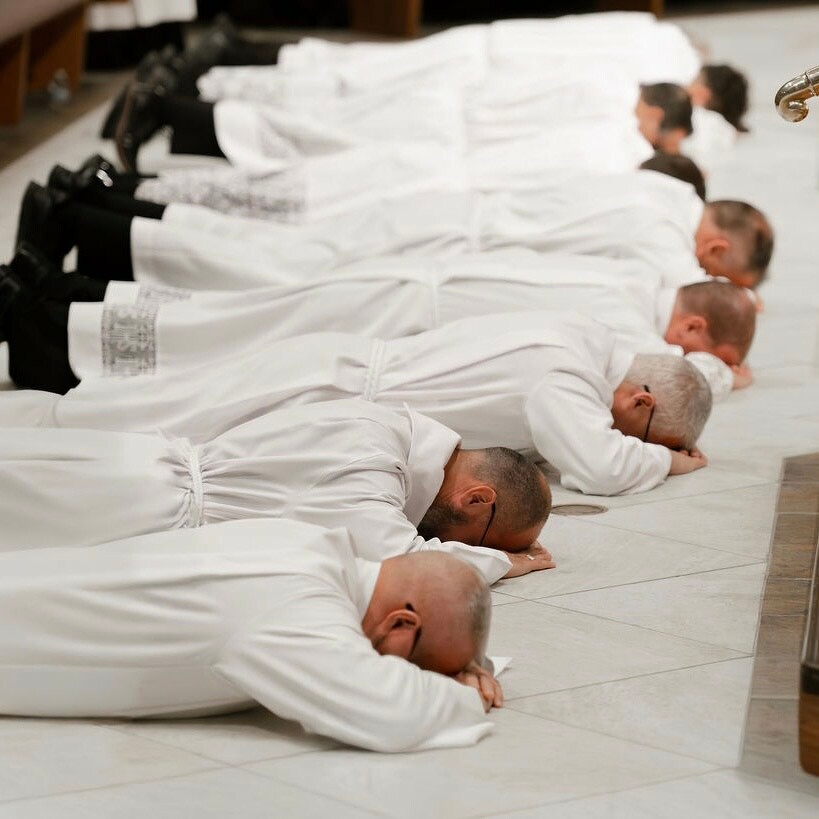
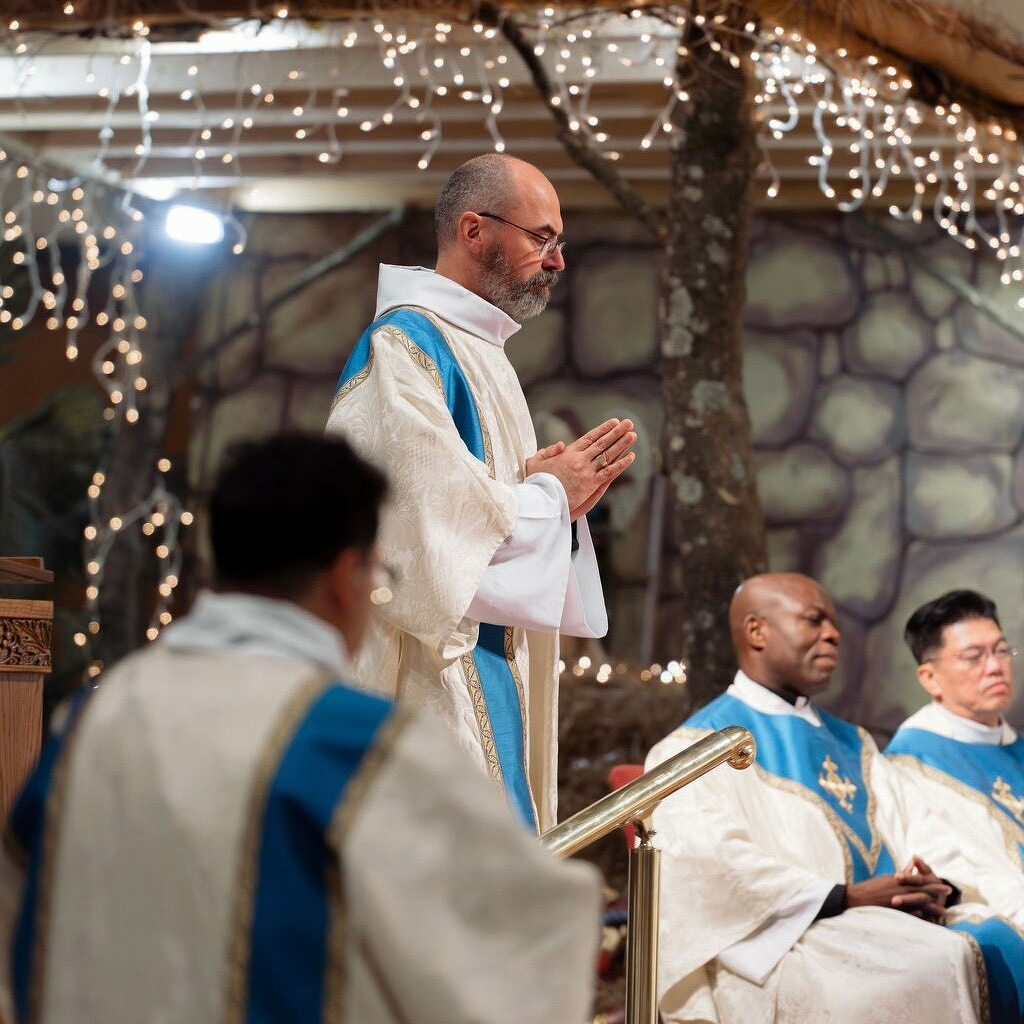
Believe, Teach, Practice
The buzz is just starting to wear off, but just a little. Father let me off the hook for preaching at my first Mass. He figured I had enough to worry about, but left me the option, and I was glad to exercise it. This let me concentrate on the other details, like remembering new places to stand, things to say, and all the rest. It was wonderful, also, to have two of my sons up there as servers. There was a nice reception afterward and a smaller dinner of family and close friends later that night. Just beautiful, end to end.
My oldest daughter is a professional photographer and got some great pictures throughout; I’ll post a few as soon as I can.
On the cusp
Starting tomorrow, I’m on PTO through 1/5, which is going to be lovely. It won’t quite be two weeks of extended relaxation, though. Ordination is on Saturday, and I’m scheduled for five masses, one of which is the very next morning. After that is the noon Christmas (in Spanish), two Sundays, and The Solemnity of Mary, Mother of God. Then the new assignment starts and I’m on for 4 liturgies per weekend: two each in Spanish and English, split over Saturday and Sunday. Haven’t quite figured out what the weeknight stuff looks like.
It sounds crazy, and I’m sure that it will definitely feel crazy, but I expect there to be a few pockets of quiet here and there and I hope to get some reading done. We’ll see. Last night was the OCIA Christmas party, and it was nice to chat with folks and try various desserts. It’s a little bit of a bummer having to leave them, but they’re in excellent hands and I trust that the Lord will do His thing between now and Easter. I will probably return at some point after the first of the year to do the contraception/IVF session.
I likewise have my last parish finance committee tomorrow. Clergy are members of these committees ex officio, so while I’m certain I’ve not seen the last of parish finance meetings, I can’t be a member in any active or voting way, which is fine. I’ve learned a tremendous amount, and I’m inclined to credit God’s providence for putting me there despite my constant confusion. Balance sheets don’t make much sense to me and all I brought to the table was a willingness to take notes and ask dumb questions. I’m neither an accountant nor do I have any background in finance. I suppose the willingness was enough.
In any case, here is some nerdspeak: I’m basically all-in on emacs now. I’ve used
it to replace my RSS reader (with elfeed), console browser (changing elinks
for eww), and email client (switching from neomutt to notmuch). Since it makes
a decent text editor as well, I’ve also kicked vscode to the curb. I haven’t tried
the irc client out yet but probably will at some point. I like my current client
quite a bit and don’t feel any particular urge to switch (weechat for anyone who
might be wondering). I’m relying pretty heavily on Claude for configuration
assistance, but it’s mostly in the form of “how can I make X in emacs act like tool Y
on the console” and the AI is happy to oblige without losing patience or telling me
how I ought to be doing it. There is a close-to-zero chance I would have gotten
this far without it; I’ll call it a win.
Book status is unchanged. I’m getting a little impatient with Pessoa, but will make a push and try to finish it out soon.
Still no radio activity. I’ll see if the mood strikes over the holidays; if not, there will be plenty of indoor time during JanuFeb for tinkering. Until then, I’ll leave you with this: CHRISTMAS WEATHER CHANNEL VAPORWAVE Vol.02 // 90s Nostalgia Mix. Enjoy!
This, that, and the other.
Still tinkering with emacs, but I’ve got my main use-cases more or less ironed-out: email, RSS feeds, and writing like this. I can toggle light and dark modes and even turn my my desk lights on and off. It’s easy to see why people just opt to do everything with it. I still need to get my head around the some of the text-editing shortcuts. Yes, I’m aware of evil-mode; I was running in to a lot of conflicts and whatnot with some of the packages I was using and was getting tired of continually adding exceptions and workaround in my config file.
Still dipping in and out of Pessoa. The individual texts are beautiful, but the overall tone is sort of depressing and the speaker (whoever that is) is continuously struck by the banality of life, but also seems to have come to peace with it. Most of the time, anyway. Religious references pop up here and there, but nothing that would have you conclude he’s any sort of believer. Pessoa himself was something of an occultist, apparently, but Soares sort of drifts along between the day-to-day grind of life and the interior castles of his books and dreams.
For study, I’ve started Congar’s I Believe in the Holy Spirit, which I got last year for Christmas. It’s slow going so far. Same for De Sales, but that’s only a chapter at a time as part of morning prayer.
Ordination is in one week’s time. Lots to do between now and then, including wrapping up some stuff at work in advance of a few weeks of year-end PTO. Last night was the middle school band concert, which was lovely. Today was a pair of basketball games. Next week has a couple of parties, and then family begins to arrive. Ordination, and I’m on the mass schedule as of the following day. I stay at my home parish until January 5, which is when my assignment officially starts. If you’re the praying sort, and I hope you are, remember me and the other candidates (two of which are preparing for the priesthood). And thank you.
Trees
There’s an enormous honey locust tree in our back yard, way back in the corner and too far away to hurt anyone with the colossal thorns that bristle along its trunk and branches. Owing to it’s shape, it wouldn’t be much of a climbing tree, but the thorns - which can and have punctured mower and tractor tires - seal the deal. Stay away, unless you’re a squirrel. It’s a nice looking tree. The leaves are lacy and small and it turns a lovely yellow in the fall. It also produces long bean-pod looking things as its main fruit. The pods, or at least the goo inside, is said to be edible and are what give the tree its name. I just run them over with the mower and chop them up, but they originally evolved to feed large animals which no longer exist on our continent.
Same as the Osage oranges, which are those knobbly looking green softballs that are all over the place along the greenway this time of the year. I was amazed the first time I saw them and immediately disappointed to learn that they are not edible. They’re not much good for anything, though I read somewhere that if you put the fruit under your bed it will repel spiders. We haven’t tried this yet, so your mileage may vary. Both the honey locust and the Osage orange (also called hedge apple) developed their fruits to be consumed by the megafauna which used to roam our landscape but faded away a long time ago. The fruit would be gobbled up in one place and the seeds passed out somewhere else. Avocados were distributed the same way. Making giant fruit with a single seed in the middle takes a lot of energy, which means the tree was counting on something which would take windfall or ripened fruit elsewhere. Not at all like maples, which cast their seeds on wings every time the wind picks up.
For what it’s worth, I did my part to try to make up for the lost megafauna. I brought home a couple of Osage oranges from the greenway and chucked them into a few spots here and there around the yard. Nothing happened, but I’m not about to attempt their customary pathway. Maybe I’ll try burying them a little next time.
Other tree updates: new Pistache trees are settling in well. The weather has been relatively mild and pretty wet, so I know they’re getting plenty of water. The quince and medlar trees are supposed to ship in late winter, around February. At the longtime request of my wife, we also added a dogwood - ‘Cherokee Brave,’ which is one of the darker pink varieties. It’s likewise doing well out front so we have high hopes for this spring.
There’s nothing in life that’s less real for having been well described. Small-minded critics point out that such-and-such poem, with it’s protracted cadences, in the end says merely that it’s a nice day. But to say it’s a nice day is difficult, and the nice day itself passes on. It’s up to us to conserve the nice day in a wordy, florid memory, sprinkling new flowers and new stars over the fields and skies of the empty, fleeting outer world.
Text 27, The Book of Disquiet
This is a strange little book; little meditations, observations, and rhapsodies on everything under the sun, as written and gathered by Senhor Soares, who may (or may not) be one of the personality/heteronyms closest to Pessoa himself. Soares is an accountant at a small firm whose days are filled a quiet routine that is gilded on all sides by his observations and occasional fantasies. Text 27 continues:
Everything is what we are, and everything will be, for those who come after us in the diversity of time, what we will have intensely imagined - what we, that is, by embodying our imagination, will have actually been. The grand, tarnished panorama of History amounts, as I see it, to a flow of interpretations, a confused consensus of unreliable eyewitness accounts. The novelist is all of us, and we narrate whenever we see, because seeing is complex like everything.
The texts seem to have been something of a lifetime project. Gathered and arranged more or less, you get the feeling that you’re reading a sort of diary or commonplace book, except that the gathered thoughts are his own, and by his I’m still not entirely sure if we mean Soares or Pessoa, and maybe it doesn’t matter since they’re one and the same person. The writer is clearly someone who finds himself in his own head an awful lot, a state probably familiar to a lot of us. Anyway, his observations of daily life are beautiful and bite sized. You can dip in and out at will without losing the thread, because there really isn’t one. Just a big of threads, along with random buttons, shiny rocks, random ticket stubs, a half-chewed pencil, a tiny ceramic dog - everyday treasure of the sort that surrounds us every day.
Notes on Notes
I wrapped up Notes from Underground while traveling yesterday. It’s not terribly long, and I figured I’d be able to finish it during one of my flights.
One of the things I’ve been using an LLM for (I favor Claude, which I’ve mentioned here before) is to set the table for some books before I start them - historical context, whether or not there are theological themes to be aware of, that sort of thing. I might ask a few more questions, skim the Foreword, and then dive in. This one was no exception, and it was good to go into Notes knowing that it was a reaction piece to Nikolai Chernyshevsky’s What Is to Be Done? which went on to become something of a classic in the Soviet canon. Reading it as an extended meditation which answers “fat chance” to engineered Utopias is profitable for sure.
Then I started the book and instead found myself imagining that I was reading someone’s blog instead and…it felt pretty contemporary. You could probably break each section of part 1 into separate posts, throw them on a Substack, and generate a fair bit of engagement. And the Underground Man’s rant starts to sound sort of coherent towards the end - that if you engineer away human needs and provide everything that is formulated to make us happy, we will almost certainly destroy it, just to feel a sense of agency again.
Then you get to part 2 - the memoir portion - to see just how horrible this ends up looking. The line between Underground Man and the murder in Crime and Punishment is straight, short, and bright. Poor Liza; I hope she eventually finds peace and warmth. Without the transcendent, the world is a bleak, bleak place where the monotony is broken only by the violence required to feel something, anything.
Notes completes the Doestoevsky arc for now. I will probably revisit Crime and Punishment and Karamazov again in the future, perhaps with different translations. As it is, I’m satisfied to leave 19th century Russia behind for a bit.

Currently reading: The Book of Disquiet by Fernando Pessoa 📚
As predicted, lots of putzing around. Hung some blinds. Will be upgrading an old laptop with an SSD to give it some new life and speed. Switched out the green breviary for the blue breviary and moved all the prayer cards, cheat sheets, and bric-a-brac to the new book. The Christmas decorations have come out and there are plans afoot to begin decorating in earnest once some of the working kids get home. We knocked out the first drop of Stranger Things and the latest episode of Plur1bus. This morning’s run was a nice and crispy 32 degrees and there were a few other folks on the greenway, plus the usual deer and squirrels.
Like the deer that years for running streams…
I felt so good after the run that I busted out a variation of one of the prayers from the Liturgy of the Eucharist in thanksgiving:
Blessed are you, Lord God of all creation for through your goodness we have this day on offer. Fruit of your love and gift beyond all reckoning, may it be for us the time of our salvation.
When bits of the liturgy start coming out in weird places, I can’t help but think that’s a good sign. Let those walls between Sunday and the rest of the week dissolve into one glorious act, like a watercolor blending from one color to another.
Glorifiquen al Señor con su vida. Pueden ir en paz.
Amen.
They say that people can be divided into two groups - those who get up early to drink mimosas and those who opt for the local Turkey Trot road race. We’re both around here, so our Thanksgiving started with the Borodash, a reasonable 4-miler that meanders around the downtown area and is the main fundraiser for several local charities. We’ve been doing it for years - my wife has run nearly all of them, starting with the first. As the kids have gotten older, they’ve joined in, and we added matching team shirts a while back just for fun. Some of us run, others walk, or mosey along. Either way, the weather was beautiful. The mimosas afterward were good too.
The rest of the day was final food prep, kid-related chaos and noise, the parade and dog show, some sports that no one really watched closely, and, finally, a whole lot of eating. Topped it off with some of Stranger Things season 5.
Today is mostly just putzing around with some house stuff: getting caught up on laundry and other minor projects. I slapped together some nesting boxes yesterday to replace the ones that are falling apart. My carpentry is terrible, but if the birds will move in, that’s all that matters. We have a lot of bluebirds around here year-round, and I think that our boxes - which stay pretty busy throughout the breeding season - are part of the reason. The other project on my to-do list, probably over Christmas vacation, is a Two-chambered Rocket Box for bats. I have a spot in the very back of the yard, which would be ideal, so it just remains to hit Home Depot and do a little shopping. I also need to figure out exactly how I’ll be mounting it up as high as bats like, but I’m sure we can come up with something. A ladder is not part of the equation. I’m not risking my life for bat habitat.
I had a chance to meet with the pastor at my new assignment the other day. It was very good to see him again, get caught up a little, and hear his various thoughts on the parish, the people, and their pastoral needs. Very much looking forward to getting to know everyone soon. Between now and then, there’s a bit of travel for work, all of Advent, most of Christmastide, and - ha! - ordination itself. Trying not to get too far over my skis in terms of planning or thinking. There’s plenty to do in the present moment, right now. Staying collected. Intentional gratitude. Continual conversion. Work. Prayer.
Books on Deck
I am closing in on the end of The Idiot and used an AI (yes) to generate some suggestions for what to read next and it came up with the following, among others:
- Notes from Underground, which will sort of complete the Dostoevsky arc I’ve been on
- Diary of a Country Priest by Georges Bernanos
- If on a winter night a traveler, Italo Calvino
- Austerlitz, W.G. Sebald
- The Book of Disquiet, Fernando Pessoa
So my year-end reading is pretty much set, alongside whatever book-of-the-now is commanding the podcasters attention and the occasional review of our formation texts.
The Diocese announced our assignments today, so I can publicly share that after ordination, I will be serving at St. William of Montevergine in Shelbyville, starting on January 5. The January start gives us all a few weekends at our home parishes, which will be nice. It’s all very exciting!
I wasn’t familiar with St. William of Montevergine, but I learned that he was a Benedictine, and a hermit to boot. He sounds like my kind of guy.
This is a formation weekend, possibly our last one, so we’ll report tomorrow for more liturgical practica, homiletics, and prayer. Excited to get started, but also a little wistful about this period - formation - coming to a close. Yes, they certainly tell us that formation never actually ends, but this expression of it certainly will.
Y por los que hablan español - por favor, su paciencia. Entiendo casi todo, pero estoy mejorando mi vocabulario teológico. Ya puedo leer (y a veces escribir) en español, entonces puedo asistir en la misa como diácono; pero tambien queiro predicar!
Still kicking the tires on org-mode, but I don’t think it’s for me right now. The main attraction I can see is To-do list/calendar/agenda integration, but we live and die by a shared iOS calendar and it takes a fair amount of idiocy to integrate it into anything outside of the Apple ecosystem, even if I just need read-only access to it for the sake of visibility. At most, I’ll take a look at the Obsidian-like features to see if they’re something I can use, or heck, revisit Obsidian itself. These systems are a bit like shopping for new notebooks. I love the idea of them, but have been fair-to-middling in my long-term adoption of them.
As it is, I have a couple of notebooks I go back to semi-regularly: one for work-related stuff, and another one that serves as a sort of spiritual journal which goes with me on retreats, though I’ve been known to scribble in it occasionally at home. A third notebook has sort of emerged as the place where I keep my homily notes. I may or may not refer to them while I’m speaking, but the act of writing them down with a pen helps me keep the main points in mind. I used a note-taking app on an iPad for a few years and it wasn’t bad, but I still prefer the low-tech/high-reward touch of pen and paper.
I started The Last Invention. About done with the first episode and it’s pretty good so far. Andy Mills was on The Dispatch the other day discussing the series, if you want to listen to a nice overview. It was good to get a reminder of how submerged in the tech landscape I still am, relative to how not submerged everyone else is. At the same time, I tend to be closer to nuts-and-bolts of technology without paying as much attention to the macro-trends which, to my ears, blend a little too easily with marketspeak and investor hype. I mean, one flavor of AI accelerationist seems to think that the goods to be obtained - a world of complete abundance made possible by AGI and a massive robotic workforce - are worth the short-term costs. Maybe they are, but I’m skeptical. Fallen man and all of that. Even if the promise does comes true, then what? Do they believe that everyone alive simply transitions to a sort of eternal retirement of leisure? AGI will usher in an end to disease and suffering? Paradise on Earth, almost within reach?
I’m skeptical for a few reasons. The first is practical. The hype-cycle around AI right now feels exactly like the early 90’s, the point at which the commercial Internet really took off and became A Real Thing. Many predictions were made, and a few of them came true, but most - if not all - of those initial market darlings faded away or collapsed once it became clear how those pesky customers would actually start using things. And that cycle was preceded by the first big chip explosion which was led, at the time, by firms like Fairchild Semiconductor. Unless you’re into deep tech, you’ve probably never heard of them, but you’ve certainly of the companies started or run by Fairchild alumni: Intel, among others. I remember walking the tradeshow floor at two of the biggest Internet-related events in the mid-90s and I can only remember two or three of the hundreds of companies in the exhibit space.
Our ability to accurately predict tech trends seems a bit suspect to me. No one at Internet World saw the rise of social media, and no one riding the initial wave of social media saw the directions it would take us or the damage it would inflict on society. About the only prediction I’d confidently make about AI is that it will certainly change things, and those things are likely to be related to porn since that’s the gravity well that all tech seems to orbit.
Secondly, and maybe this is just an artifact of being a slightly grumpy old man in the tech space, tech never seems to work quite as well in practice as it does in the advertisements and investor presentations. Have you tangled with a printer lately? Exactly. Given the inexorable urge to monetize All The Things, the AGI-powered robot in your home is likely to be belting out commercial jingles 24-7 or stocking the fridge with products willing to pay for best placement, unless you’re willing to pay for Robotic Help Platinum, offering a Reduced Advertisement Experience for only 59.99/month. If the urge to innovate is strong, the urge to enshittify has proven to be nearly as strong.
But the reason I’m not feeling the imminent-Eden scenario is that sin is still a thing, and that however hard the AI folks want to believe otherwise, humans will find ways to sin and will keep doing so until the Lord returns to wrap it all up. We will, of course, be focused on this very thing this Sunday. Envy, wrath, lust, acedia…all of it will find a home in whatever place we inhabit, however shiny and new it happens to look.
To be clear - and I say this as someone who uses chatbots pretty regularly for various things - I think the tech is pretty neat and has the potential, even if it doesn’t progress any further than it has today. Like all tools, it has its proper place and we should think prudentially about where it’s used, and by whom, and for what purposes. Any tool can be abused, and serve to do injury to the dignity of the human person; this one is no exception, and carries the additional dangers of being opaque in its operation while simultaneously presenting itself as coldy impartial. I’m thankful for the work that the Holy See has done in this area and recommend the book produced by the AI Working group: Encountering Artificial Intelligence.
Got the other trees into the ground yesterday, as I was hoping to have them planted before a whole pile of rain comes drifting into our area. It was…weirdly warm and today got into the mid-70s. I’m not complaining (much) but I have a feeling that we’ll be paying for it later on in the year.
Remember when you were grousing about the heat? How do you like this, good sir? as we watch the mercury drop even further and our faces hurt from the air.
We have our assignments but are under a strict embargo until they’re announced by our bishop. They’re his prerogative, so he gets to make the announcement which, I think, will be this weekend. Until then, lots of quiet preparation and prayer. I’m teaching OCIA tonight and our subject is The Liturgical Calendar, which is unquestionably the critical hinge point on which the entire creed rests. It will be a barn-burner, I can tell you. There may or may not be levitation; you’ve been warned.
I will, as in years past, start with a small explanation of what liturgy is and isn’t, what it requires and what it most certainly does not require. I also have the opportunity of maybe going down one of my favorite rabbit holes, which is the dating of Christmas and the inevitable questions around who cribbed from who in terms of the winter solstice. If you’d like to know more, take a look at Calculating Christmas by William Tighe or the very excellent The Origins of the Liturgical Year by Thomas Talley, who is Tighe’s main source. It is…exhaustive, and also magnificent.
As long as we’re at the outer limits of nerd, I’m writing this from emacs org-mode. Why? I’m still not entirely sure yet. The organizing tools intrigue me, and I’ve made an embarrassing number of attempts to learn emacs over the years before inevitably returning to vim for editing stuff; org-mode seems like an interesting use-case for which it might be worth learning…all the rest. The jury is still out, I’m afraid. I want to try to get calendar syncing working, at least in read-only mode before I take the big plunge. Writing here and posting directly to the blog is something I was able to do in VSCode too, both functions thanks to Claude who wrote the plugins/scripts/doo-dads to make it possible.
Postscript: class went well. Nobody asked about Christmas, which was fine.

Currently reading: I, Rigoberta Menchu by Rigoberta Menchu 📚
